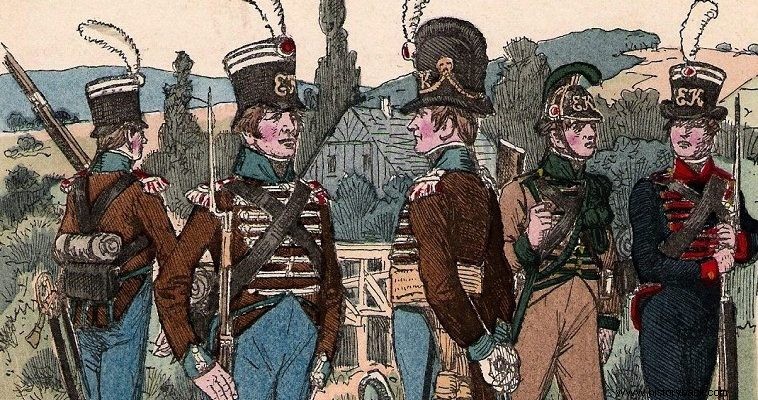
The Legion formed three times by the Archduke Charles of Habsburg, although a volunteer body, acted with considerable success against the French armies where he was called to face them. In 1792, Archduke Charles formed his homonymous "legion", in present-day Belgium, for the first time.
It was a volunteer formation manned by Belgians opposed to France. Two companies of this division, with a total of 231 men, fought heroically at the Battle of Asfenburg in 1796.
In November 1800 Charles, governor of Bohemia at the time, formed a new legion of Bohemian and Moravian volunteers. He eventually managed to assemble a corps of 20,000 men who formed 20 battalions each with six companies of 180 men. The defeat by the French in 1800 resulted in the dissolution of the body.
In 1808, Charles was named by the Austrian emperor and his brother Francis as commander-in-chief and he immediately undertook the organization of a national guard whose value was particularly demonstrated both in the war of 1809 and in the campaigns of 1813-14 against Napoleon.
In view of the war with France in 1809, Charles also reconstituted the old legion. Its formation began in March 1809. Six battalions of Bohemian volunteers were formed. Another three battalions were formed by volunteers from Moravia and Silesia.
The last three battalions formed the "Moravian Free Corps", which was attached to the legion. These nine battalions had a total strength of about 8,000 men and were organized like the "German" infantry battalions of the Austrian Army, with six companies of musketeers.
Contrary to what is generally believed to this day, these battalions were largely battle-worthy. The first three joined the forces of Charles with which he invaded, in April 1809, Bavaria, an ally of the French.
The 1st Battalion, known as "Waltrich's Hunter battalion" was composed of men skilled in the use of weapons, mountain hunters. The battalion acted really heroically in the battle of Tagenhausen, in the so-called "Austrian Thermopylae", where it lost half its strength and later in the famous battle of Bagram in which it participated with a divisional force (243 men).
The 2nd Battalion consisted of Czech and Austrian volunteers. He also fought well in the battles of Aspern – Essling and Wagram. The 3rd and 4th Battalions also fought at Bagram. The 5th and 6th Battalions did not participate in major battles, performing mainly guard duties in Bohemia.
The three Moravian battalions were composed mainly of mountain hunters, too. The Brno-based 1st extended 1,113 men, the Olmuz-based 2nd extended 933 and the 3rd extended 1,269. The 2nd Battalion fought at Aspern – Essling and Wagram, while the 3rd was based at Wagram. The 1st performed guard duties.
The men of the legion had not undergone formal military training. They were usually obliged to take part in some dense class exercises and shooting at least on Sundays a year. The men with hunting experience relied mainly on this and the command used them as light infantry snipers.
Their armament was accordingly also proportional.
Hunters were usually armed with pattern 1807 or earlier rifled rifles, but also with the then innovative Repetierwindbusche M 1780 repeating air rifle, which could fire 20 rounds before needing a reload.
But the main weapon of the legionnaires was the musket. They were usually armed with the older Model 1798 muskets, but also the newer Model 1807. They also carried a typical long, triangular bayonet. Non-commissioned officers carried a distinctive staff and short sword. Officers carried a sword or swords and a gold-braided cloth belt.
The men wore a shako hat but the officers often even wore civilian hats (semi-high) with the brim. All wore the letters EK (Erzherzog Karl =Archduke Charles) embroidered in gold on their hats. Some units of hunters wore helmets like those of the regular Austrian infantry. The tunics were tile-colored and had ribbons. The peridots were blue in color.
The legion could not be considered an elite formation. Yet her men, though they had not undergone regular military training, at least fought satisfactorily when called upon. Their morale was also quite high as they were all volunteers who enlisted to defend what was important to them.
Even more remarkable is the fact that these volunteers, in their vast majority, were not Austrians, but Czechs who theoretically should not be fighting for their overlords. Charles' legionnaires also fought because of the respect they had for his person. Charles was a great general and especially loved for his kindness and fair judgment.
The humble musketeer of the legion lacked the professionalism of his typical counterpart in the Army, but on the other hand he made up for this lack with his courage and loyalty.
They performed even better in the wars of 1813-14 when they joined the national guard.
/P>
